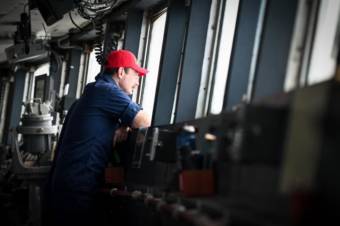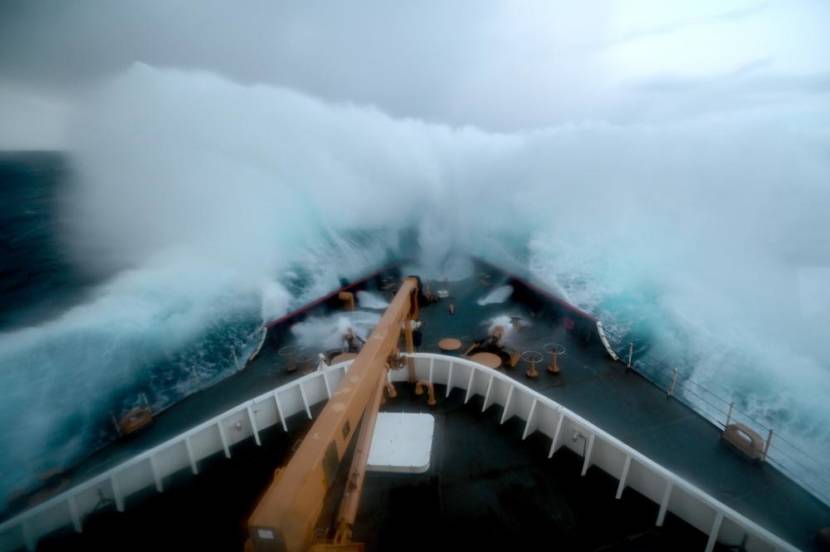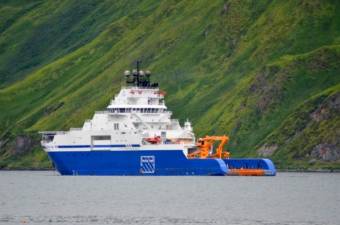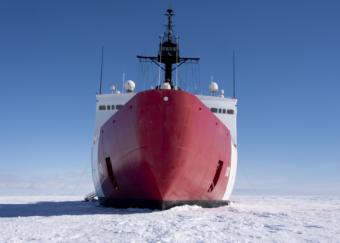
The nation’s sole heavy icebreaker arrived in the Aleutian Islands this week for the first time since 2013.
The U.S. Coast Guard’s Polar Star is preparing to patrol Alaska’s Arctic waters, including the maritime boundary line separating the U.S. and Russia.
The Polar Star sits in the Port of Dutch Harbor. The ship is nearly 400 feet long and can break ice up to 21 feet thick.
The ship arrived with 136 crew members on Tuesday for a pit stop 30 days into a months-long deployment to the Arctic to assert maritime sovereignty and security in the far north.
“The Arctic is incredibly important to us strategically, because of the amount of gas and oil and resources, as well as the fish stocks, which are landed here in Unalaska,” said Capt. Bill Woityra, the cutter’s commanding officer. “These are absolutely U.S. sovereign resources, and we desperately need to protect them against foreign actors, whether it’s foreign fishing fleets or it’s foreign adversaries that are seeking to push the limits of international law and claim those things for themselves.”

Typically, this time of year, this special icebreaking cutter is on its way to Antarctica’s McMurdo Station to drop fuel and other supplies to American scientists doing research near the South Pole.
“But this year, with the global pandemic, they had to cancel the mission,” Woityra said. “That created the opportunity for the Polar Star to come back north again.”
This is the ship’s first winter Arctic deployment since 1982.
In addition to the cutter crew, there are partner-agency researchers and scientists, British sailors from The Royal Navy, midshipmen from the Merchant Marine Academy and deck watch officers and ice pilots from the Healy, the Coast Guard’s medium icebreaker that’s capable of Arctic patrols during summer months.
According to Woityra, the mission isn’t only about national security and securing U.S. economic interests as human activity and international interest in the region expands. It’s also about doing environmental research.
They’re partnering with the Woods Hole Oceanographic Institute to take water samples and measurements while the boat transits over the Arctic Circle to better understand the harsh environment there. Getting data in the remote region during the winter, Woityra says, is otherwise extremely difficult.
“Basically, a heavy icebreaker is built so we can go anywhere on the earth in any thickness of ice during any time of year,” he said.

Even though the Polar Star was built to break through thick ice, just a month into their Arctic deployment, Woityra said the season has been tough on the 44-year-old vessel.
“Breaking ice in the Arctic winter is especially challenging because it’s so hard,” he said. “It sounds like a car crash, just twisting metal and screeching noises and shattering glass. It’s really kind of disconcerting. There’s no danger, but it leaves an unsettling feeling in your stomach.”
He said the crew has been working around the clock just to keep the ship running. On New Year’s Eve, they got stopped in the ice, and their engineers were up all night working to replace blown diodes and resistors that are usually considered obsolete.
“These are parts that just don’t exist anymore,” Woityra said. “We have a warehouse of spares, but when they’re gone, we won’t be able to run this ship anymore.”
That’s why Woityra and other Arctic planners say it’s so important for the government to invest the billions of dollars needed to build new icebreakers in the next decade to replace the Polar Star, which is the nation’s only functional icebreaker after a fire damaged the Healy this past summer.
The federal government is in the process of commissioning one, and Congress has agreed to build five more, but it hasn’t allocated funding.
The construction on the first new ice breaker is expected to be completed in 2024. Woityra said it will be 460 feet long, 90 feet wide, and weigh 23,000 tons — almost twice as much as the Polar Star.
“It’s going to be the largest, most complex, most powerful ship that the Coast Guard has ever built,” he said.
In the meantime, Woityra said the Polar Star’s Arctic mission will help train the future generation of Arctic sailors and mission leaders.
“This is our chance to really build up that experience and expertise and hold our proficiency operating in this environment,” he said. “Once those polar security cutters are delivered in a few years, we’re going to need operators and leaders to actually take them to sea, and we desperately need them to have experience in this environment.”
The Polar Star is expected to leave Unalaska’s Port of Dutch Harbor on Thursday afternoon. Woityra said he expects they will complete their mission and return to Seattle by the end of February.


